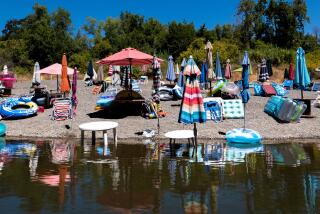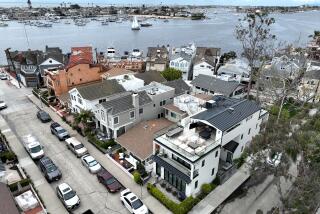Idyllic N.H. Lakefront Tarnished by Growth
- Share via
LAKE WINNIPESAUKEE, N.H. — Deer came to drink this morning and left their hoofprints on the beach where Lilie Brown Parsons walked in solitude as a young woman at the turn of the century.
Nearby stands a storm-scarred wooden windmill with hand-carved propellers, a failed attempt by Parsons’ son, Dave, to generate electricity for the cottage.
It sits beside the covered boathouse Parsons’ husband pushed across the ice in 1897 and lived in with the carpenter while the cottage was being built.
To reach the cottage from her home outside Boston, Lilie Parsons would travel 100 miles north by train to Weirs Beach on the western edge of Lake Winnipesaukee, the state’s largest lake at 70 square miles. There she would catch a steamship to Long Island, where she rowed across a bay to Parsons’ Point. The steamship schedule for 1898 is still posted on the cottage wall.
Parsons’ visitors signed her cupboard door in script now almost too faint to read. A banister made of a white birch limb, the bark darkened by a thousand hands, offered support up the narrow staircase to one of two bedrooms on the second floor.
No Electricity
A while back, Parsons’ three great-grandchildren voted not to install electricity. Doing without gives them a better understanding of life in her days, they say.
Outdoor showers are provided by a gravity-fed hose hooked to a storage tank in a second-floor bedroom closet. A 12-volt battery runs the pump used to fill the tank. The outhouse is a two-staller, lit only by sunlight filtering through cracks in the plank walls.
Despite such efforts by old-time lake dwellers to preserve their quiet life style, Parsons’ cottage has become an endangered species.
Spurred by a real estate gold rush that has pushed the price of premium shorefront property to $1,500 to $3,000 a foot, developers are filling the shores surrounding the cottages with citified homes and row-house-style condominiums.
Many new projects are funnel developments, with narrow spits of lakeside access that widen as the distance from the shore increases.
Expensive Condos
Lakefront condominiums priced less than $100,000 are rare. Condominium boat slips on Winnipesaukee can cost $55,000. Proposals to limit the number of docks to keep lakes from becoming cluttered would put an even higher premium on the few permitted.
Philip Parsons, Lilie Parsons’ grandson, remembers playing as a boy on Long Island in the 1940s, when the cottages ringing the eight-mile shore numbered no more than 10. Now, he guesses as many as 200 homes on the island have lake vistas.
The housing boom has begun to change New Hampshire’s lakes--once primarily retreats for vacationing blue-collar workers--into exclusive havens for the wealthy. Old estates, rental cottages and camps are vanishing under the bulldozer’s blade.
During the last few years, Philip Parsons and his wife, Ginger, both 61, lost their bid to stop a 32-unit funnel condominium development across the bay from their cottage. But that defeat, and a condominium development on the other side of the island that the family calls “the rape of Long Island,” prompted the creation of the Long Island Landowners Assn. It also led to tightened controls on growth along the town of Moultonboro’s 65 miles of lakefront.
Problems Elsewhere
Families in other lake towns also have organized to fight uncontrolled growth.
Stronger than most and backed by old family money is the Squam Lakes Assn., whose domain encompasses the lake and cottage featured in the 1981 movie “On Golden Pond.” The association has a special fund to fight developments its members consider inappropriate, but no one considers the situation under control.
“There are some potential big lots and people bite their nails a little,” says Phil Preston, executive director of the 1,500-member association. “We have a sum of money that has been raised for that eventuality, but I’m not sure it’s enough.”
The Parsonses don’t object to growth as much as its visibility. They say that, rather than nestle houses into the landscape, developers have bulldozed trees and planted grass to the water’s edge, dousing it with fertilizer that soon enters the water.
“As new people come up, they accept this as the norm,” Philip Parsons says. “It doesn’t bother them as much as those of us who’ve been here quite awhile. . . . This is beginning to look more like Long Island, New York, than Long Island, New Hampshire.”
Boats Intrude
At Harilla Landing, a few hundred yards from the development the family battled, Ginger Parsons points to a pair of catfish hovering over a newly hatched brood under a dock. The brood moves slowly, an underwater ink spot.
A high-powered boat capable of speeds topping 100 m.p.h. rumbles by, its motor drowning the morning stillness.
As many as 20,000 boaters cut wakes on the lake on a weekend day in the summer, and that has heightened tension between boaters and landowners.
“The perimeter’s private; the water’s public. The people on the perimeter want to discourage public access,” state Sen. Roger Heath says. “There’s always a zone of trouble between public and private uses.”
Besides the noise, the Parsonses say some boaters don’t respect the privacy of landowners or the environment.
“They throw trash into the lake,” Philip Parsons says. “They use the lake as a toilet. Then they pull their boat out and go 50, 100 miles away, leaving the problem behind. We’re the ones who have to cope with it.”
No Weekend Visits
The Parsonses no longer visit their cottage on weekends, when the lake is crowded with boats.
“We’ve nearly been swamped more than once in our Sunfish,” Philip Parsons says.
New Hampshire is leaving the boaters’ fate--and that of the lakes’ landscapes--to market forces and lake communities. The instrument of control for the communities is zoning. But ordinances often are nonexistent or vary widely from town to town in a state that prides itself on respecting individual rights and home rule.
A struggle on Lake Sunapee epitomizes the conflicts that result. A Massachusetts man is building a 10-foot-wide house down the center of a narrow shorefront lot. Though no zoning ordinance bars the project, a neighbor is suing to try to stop construction.
Although large tracts of lakefront land are subdivided and sold at a frenetic pace, the numbers of state parks, boat ramps and beaches stay constant, despite what some see as significant opportunities for expansion.
State Rep. Edward Bennett, who lives on Newfound Lake, says the lack of a statewide zoning law is also threatening public access to the lakes.
‘Sealing Off Use’
“When you take 400 feet of shoreline and put in 40 homes for the wealthy, it gives 40 people the right to have a mooring or two and privacy and exclusive use of the lake,” he says. “We’re being land-raped as far as I’m concerned. It’s sealing off use of the lake from the general public.”
The Parsonses tell other landowners of the advantages of donating land in trust, hoping to preserve some of the lake’s landscape.
There have been rewards. The town’s new zoning ordinance has squelched large, funnel developments of condominiums.
A statewide land trust established in October by business leaders and environmentalists is seeking a $50-million state bond issue to buy land and development rights. The trust is targeting key parcels--including lakefront, islands and river basins--to protect public access and open space.
Despite signs of progress, Philip Parsons sometimes sees the way of life the cottage symbolizes vanishing no matter what he does.
Holdings Dwindle
Like those of many old-time lake families, the once extensive holdings of great-grandfather Brown have dwindled over the years. Dave Parsons, now 81, deeded Philip and Ginger Parsons the point, windmill and cottage on three acres about five years ago.
Relatives own land on both sides. But, like most other inheritors of the land, the Parsonses say they could not afford to buy at today’s prices.
Dependent upon the whims of coming generations, their buffer is as fragile as the yellowed paper tracings of fish caught nearly a century ago that are tacked to beams in the small living room of their cottage.
Loons still sing in the cove near the beach the Parsonses call Cousins’ Beach “because everyone you’d meet there was most likely your cousin.”
A gash in the trees nearby is all that remains of Philip Parsons’ mother’s cottage, which burned after being struck by lightning two years ago. Firefighters saw the glow but had no way to reach it except by boat.
The family could have built a driveway, but refused.
“Any road is the invitation to the casual driver,” Philip says.
More to Read
Sign up for Essential California
The most important California stories and recommendations in your inbox every morning.
You may occasionally receive promotional content from the Los Angeles Times.






